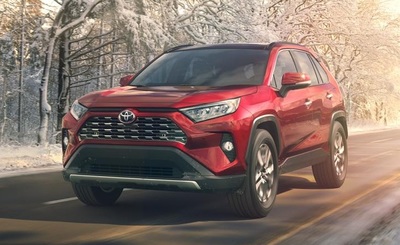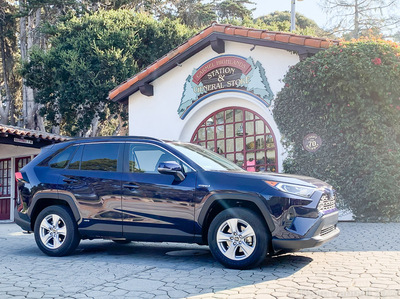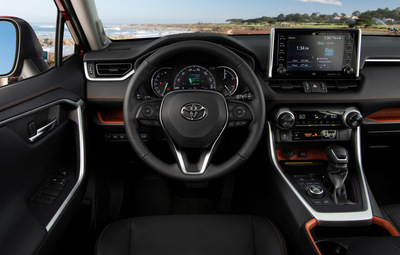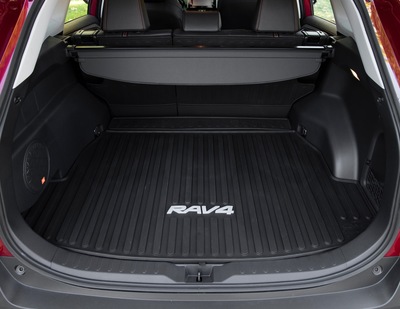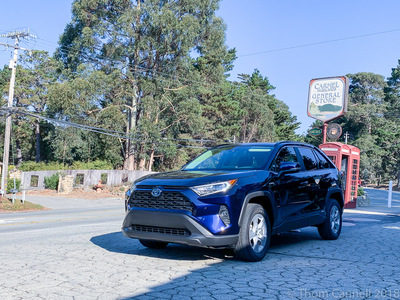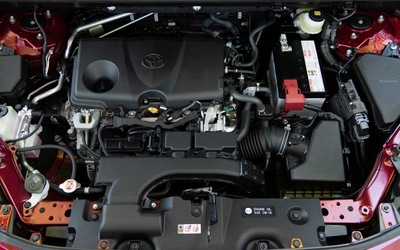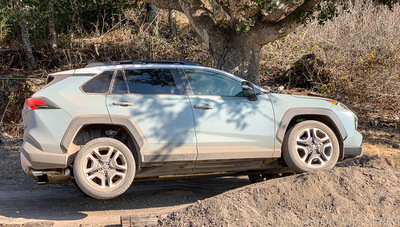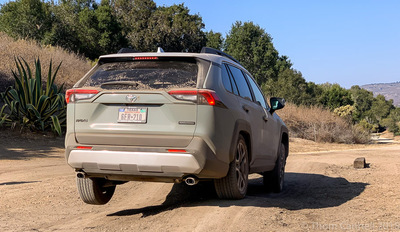2019 Toyota RAV4 Review; The Best Gets Better - Expert Opinion By Thom Cannell - It's E15 Approved
2019 Toyota RAV4
The best gets better
By Thom Cannell
Senior Editor
Michigan Bureau
The Auto Channel
Though we said “best” in the headline, besides improvements in every area, RAV4 is the best-selling CUV/SUV in North America. And, according to Toyota, it outsells every vehicle other than pickups.
Launched in 1994 and refreshed in 2001, 2006, 2013, RAV4 is a bit overdue for a change. Yet, despite its increasing age, volume has doubled in the last five years.
The first thing we noticed about the all-new model was its truck-like front end, complete with hints of Toyota’s Tacoma and Tundra. The look is far bolder and adroitly chiseled. The new platform also has rear multi-link suspension, and we were interested in how that would affect its ride and handling.
Toyota informed us that their ownership is mainly young singles, couples, and early families before the number of kids makes a larger vehicle necessary. As expected, prices are higher for each model, yet the standard content added is worth far, far more than the increase. Well, except for the most-powerful model, the Hybrid. It’s $925 less than the outgoing hybrid.
There were multiple design goals for the 2019 RAV4, including a more car-like feel with more SUV capability. They also wanted a higher quality interior with greater outward visibility, which we’ll get to momentarily.
There are, of course, a variety of drive systems, from Front Wheel Drive only, to two different All Wheel Drives, and Hybrid models. For the first time, one AWD system delivers true wheel-to-wheel torque vectoring. Which simply means that the drive system wastes no power on slipping wheels, and that the system can—transparently—aid in cornering. This, everywhere but total sunshine states, is a very good thing. Even in those states, come the monsoon, any all wheel drive system will get you through the water with enhanced safety.
There are minor changes to the boxes that make up the refreshed exterior, it’s a teensy bit shorter (-0.2), a bit wider (+0.4), and ground clearance is much better, growing a full 2.3-inches, yet the tumblehome is similar. It’s easy to sit into. Toyota added their latest safety suite, made LED headlights standard (we didn’t’ drive at night, we’ll have to wait a while to evaluate them), and added a sturdy Adventure model that we greatly liked.
Inside, soft touch is the word of the day, and there are eight cupholders and five USB outlets. Therefore, one USB per passenger and 1.6 cupholders. The instrument panel is fully electronic, and it’s very chic, with upgrades like a choice of analog or digital display that, in the center Driver Information Center, changes color. It uses Red for Sport, Green for ECO and background when selecting Normal drive mode.
Some changes are harder to see, like the enhanced cargo space with bi-level deck for cargo management, or the kick-under auto-lift tailgate. That’s always a pleasing feature for grocery-filled arms. Some are easier to find, like the standard 7-inch touch-screen infotainment (8-inch optional touchscreen) with Apple CarPlay which now uses Waze. Toyota has done the deal with Amazon, so Amazon Alexa is also available, as is an 800-Watt JBL sound system that uses Clari-Fi to enhance down-sampled audio signals like SiriusXM, AM and FM, and any older 128-bit music you might be listening to.
Because safety is extremely important to all of us, Toyota’s Safety Sense includes Pre-collision with Pedestrian Detection, enhances speed reduction (brake assist), camera-based road sign detection that visualizes and displays Stop, Yield, Do Not Enter, and Speed as tiny road signs in the Driver Information Screen.
Also included on many models is Lane Trace Assistance, there to both beep and nudge your vehicle back into its lane. It works well. It also detects vehicles ahead and adjusts cruise control speeds with the standard Dynamic Cruise Control. For the technically inclined, they’ve now mounted the lane assist motor directly to the steering rack and beefed up the steering shaft. Oh, there’s the wonderful Blind Spot Detection, bumper-protecting sonar distance warning, and Cross Traffic Alert.
Under the hood is a single engine, a 2.5-liter high-revving four-cylinder that is rated at 203 horsepower. The XLE Hybrid, with its two e-motors, ekes out 219 hp. and is the mileage champion, with 39 Combined rating to the normal engine’s 29 mpg. Again for the techies, e-motors MG-1 (front) and MG-2 (rear) are now more compact and deliver 30-percent more torque and higher rpm capability. What surprised us is that Toyota has continues to use nickel metal-hydride batteries. We speculate it’s a cost-based decision, as well as them being smaller and lighter.
Back to the powertrains and their AWD systems. LE and XLE models with optional AWD can split torque 50/50 to the rear as needed. Limited and Adventure grades use Dynamic Torque Vectoring that can split torque up to 50/50, and left-to-right using mechanical couplings. (Note that the Adventure can tow a respectable 3,500 pounds.) The system includes several selections for terrain, like rocks or sand. The Hybrid, however, can deliver up to 80-percent of its available torque to the rear axle. Each AWD system differs in how it tackles off roading.
When engineering and designing the new RAV4, no specific vehicle was targeted for benchmarking. Instead, focus was on improving their AWD system, specifically adding torque-vectoring capability. Thus, both AWD systems default to FWD, but any demand of acceleration or slippage will activate AWD, cornering, single wheel-slip, or large steering input will activate the dynamic system.
With that information under our belts, we took off on the Pacific Highway in the Hybrid. Right away we notice improved damping along with perfectly calibrated spring rates; a totally better package. Steering felt tight, as in direct and communicative. The Hybrid offers three driving modes, Eco, Normal and Sport. There seemed little difference among them, though if you shifted the CVT transmission, it simulated six gears. Our notes say, “upshifting is silly, downshifting does something.” In all, it was pleasant and appropriately powerful with two average people on board.
What we liked the best was how quietly, other than wide open throttle, the small crossover went about the business of driving on twisting two-lane roads. It felt utterly competent and quiet. So we turned it in for an XLE non-hybrid with an 8-speed automatic instead of the hybrid’s CVT transmission.
Our first note says, “Engine noise precedes any GO!” That’s when stomping the pedal flat to the floor. Otherwise, it was quietly competent. We did note greater difference in downshifting when in Sport mode, and, if you were accelerating extremely hard while making a big turn, there was noticeable—but manageable—torque steer. Thus, unless you were us, thinking, “Hey, we’re gonna test this sucker HARD,” you’d be hard-pressed to notice any rude input from the drive system.
We had a mutual preference for they Hybrid model, as the XLE felt heavier compared to its stable mate. And we were pushing hard, uphill and downhill in the 5,000-7,000 rpm range. Oh, this small engine is very happy at high rpms! When driving modestly, as most sane people will, even shifting gears in Sport mode, the XLE provided good fun. Bottom line, if there’s not too great a price difference, buy the Hybrid. Hmmm, that leaves a Limited that we have not tried on the road...
After driving on the road, Toyota convinced us that RAV4 was meant for adventure, so we visited a man-made off road park to check capability of the two AWD systems. Remember, it’s the Adventure (and Limited) model with the mechanical AWD system; Hybrid models are different, using braking to achieve torque distribution. We set the Adventure model’s AWD system into Off Road Rock & Dirt mode. Heading downhill, using its Downhill Assist Control, it moved us gracefully down a steep decline. Toyota says the system works equally well backwards, for instance if the hill you’re climbing is simply too steep or slippery.
Going uphill, the Rock & Dirt setting moved us up, while Mud & Sand allowed too much wheel slip. There is a demonstrable difference in what these AWD settings do for you, the driver.
We repeated the course in the Hybrid. It, too, completed the drive, though the driveshaft isn’t mechanically coupled, as in the Adventure model. It uses the front and rear e-motors, so… Wow!!! Great banging and clanging as the ABS system alternately braked and released slipping wheels. If you’ve never experienced a similar system, or full-ABS stop, know that the auditory drama is simply the system working as engineered. Without that knowledge you could be startled, perhaps terrified!
The Good:
Greatly improved design, comfort, and quietness. Capabilities are also improved by re-imagined AWD systems, and the Hybrid seems to us to be the better of two worlds.
Needs Improvement:
The Hybrid models would benefit from a more-distinct difference between ECO, Normal and Sport. And every salesman MUST explain that ABS system noises will occur if you take that very good SUV out into the boonies on wet, slippery days.
Cool Hacks:
Great seats with woven-in colors, Apple CarPlay, Amazon Alexa integration. A motor that will rev beyond the heat death of the universe.
Thom Cannell
Thom@CannellAndAssociates.com
Copyright 2018 First North American Serial Rights Unless Otherwise Noted.
Photos copyright 2018 by Thom Cannell
The Most In-Depth Independent Toyota Vehicle Consumer Research - Anywhere!
- Toyota Buyers Guide | Specs, Prices, Expert Reviews and Comparisons 2019-1997
- Find Your Perfect New Car Match
- Toyota Reviews From The Auto Channel (1993-Present)
- The Auto Channel's Toyota Brand Archives; News, Press Releases, Reviews, Specifications, Prices, Video, Images (133,009 Annotations)



